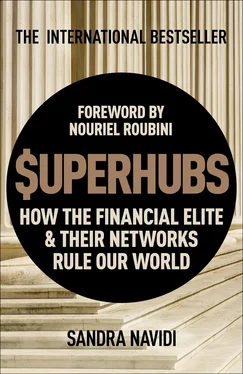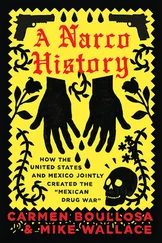Sandra Navidi - SuperHubs - How the Financial Elite and Their Networks Rule our World
Здесь есть возможность читать онлайн «Sandra Navidi - SuperHubs - How the Financial Elite and Their Networks Rule our World» весь текст электронной книги совершенно бесплатно (целиком полную версию без сокращений). В некоторых случаях можно слушать аудио, скачать через торрент в формате fb2 и присутствует краткое содержание. Год выпуска: 2017, Издательство: Hodder & Stoughton, Жанр: Старинная литература, на английском языке. Описание произведения, (предисловие) а так же отзывы посетителей доступны на портале библиотеки ЛибКат.
- Название:SuperHubs: How the Financial Elite and Their Networks Rule our World
- Автор:
- Издательство:Hodder & Stoughton
- Жанр:
- Год:2017
- ISBN:нет данных
- Рейтинг книги:4 / 5. Голосов: 1
-
Избранное:Добавить в избранное
- Отзывы:
-
Ваша оценка:
- 80
- 1
- 2
- 3
- 4
- 5
SuperHubs: How the Financial Elite and Their Networks Rule our World: краткое содержание, описание и аннотация
Предлагаем к чтению аннотацию, описание, краткое содержание или предисловие (зависит от того, что написал сам автор книги «SuperHubs: How the Financial Elite and Their Networks Rule our World»). Если вы не нашли необходимую информацию о книге — напишите в комментариях, мы постараемся отыскать её.
SuperHubs: How the Financial Elite and Their Networks Rule our World — читать онлайн бесплатно полную книгу (весь текст) целиком
Ниже представлен текст книги, разбитый по страницам. Система сохранения места последней прочитанной страницы, позволяет с удобством читать онлайн бесплатно книгу «SuperHubs: How the Financial Elite and Their Networks Rule our World», без необходимости каждый раз заново искать на чём Вы остановились. Поставьте закладку, и сможете в любой момент перейти на страницу, на которой закончили чтение.
Интервал:
Закладка:
THE REVOLVING DOOR
The “revolving door” refers to a professional dynamic in which employees move between the public and private sectors, thereby weaving a tight web of connections. As Bill Moyers so aptly put it, there’s a “revolving door between government service and big money in the private sector spinning so fast it becomes an irresistible force hurling politics and high finance together.”3 Such crisscrossing between sectors raises conflict-of-interest issues, but it is also a powerful way to build one’s position as a superhub. Relationships across the private and public sectors facilitate the spread of information and influence ways of thinking in both directions. Public officials may attribute more credence to private sector opinions on certain issues; moreover, they may try to stack the odds in their favor of later getting a lucrative job in the financial industry. While public service is generally well compensated, it does not compare to the earnings potential typically found in the private sector. For instance, in 2013 Ben Bernanke earned a yearly salary of about $200,000 as chairman of the Federal Reserve. Shortly after leaving the Fed, he made a minimum of $250,000 for a two-hour speaking engagement on the conference circuit.4
The list of top financial industry executives and senior public servants who move back and forth between sectors, sometimes several times, is virtually endless. To name only a few examples: Former U.S. treasury secretary Tim Geithner joined private equity firm Warburg Pincus; former U.S. Treasury Secretary Larry Summers was a highly paid adviser to Wall Street firms before heading President Obama’s National Economic Council and thereafter returned to Wall Street in various advisory roles; and Hank Paulson was co-CEO of Goldman Sachs before becoming U.S. treasury secretary under the George W. Bush administration. Peter Orszag, Bill Clinton’s economic adviser and director of the Congressional Budget Office under Obama, landed top jobs at Citigroup and Lazard after leaving the public sector. David Lipton, who had served as undersecretary of the treasury during the Clinton administration, later held a senior position in global risk management at Citi before becoming special assistant to President Obama. For the past few years, Lipton has been deputy managing director of the IMF. Following his tenure as commerce secretary under President Bill Clinton, William Daley became head of global government relations at JPMorgan, before returning to the White House as Obama’s chief of staff. In 2016, Mervyn King, the former governor of the Bank of England and outspoken bank critic, surprised many when he became senior advisor to Citigroup.5
The Oscillating Megahub: Robert Rubin
Any account of revolving doors would be incomplete without the mention of Robert Rubin. But where to start? With his positions at Goldman Sachs? With him becoming treasury secretary in the Clinton administration? Or how about his subsequent role as board director and senior adviser at Citigroup during the crisis, or President Obama’s unofficial “head of human resources,” or cochairman of the Council of Foreign Relations? The number of prominent positions Rubin has held in the private and the public sectors is almost without precedent. He is the human embodiment of a superhub, located in the center of a densely woven, high-caliber web that covers all the bases: finance, politics, business, and academics.
Omnipresent and omnipotent, Rubin has had immense overt power as well as subtler influence. He outwardly seems like the antithesis of the stereotypical financier, yet he is the epitome of one. Rubin is low-key, with the benevolent air of a cerebral, slightly absentminded professor. He has full gray hair, and his wiry figure and alert eyes give him a youthful appearance. His demeanor is understated and unpretentious, and his reputation is one of decency and trustworthiness. In a world dominated by loud and flashy characters, Rubin exudes serenity and tranquillity. He is known for retaining self-control at all times and his ability to remain detached from the events around him.
After earning an undergraduate degree from Harvard, Rubin attended London Business School and thereafter graduated from Yale Law School. He began his career at the prestigious law firm Cleary Gottlieb, where he had his first brush with arbitrage traders, who contacted him to elicit information on deals. After a couple of years, he moved on to Goldman Sachs, where he started out as a risk arbitrage trader. Arbitrageurs exploit price differences in the markets by legally obtaining information, typically through close relationships with people who likely have it, such as lawyers, accountants, and other finance professionals. Rubin had a knack for making connections and thrived on Goldman’s platinum network and access to information. With his intellectual and sociable personality, he was practically predestined for arbitrage. His sound and quick decision-making ability earned Goldman and himself a fortune. Soon he rose to the top position of cochairman.
In 1993, Rubin made a quantum leap to the public sector when he became the director of the National Economic Council, a position President Clinton had created specifically for him. Charged with designing and implementing economic policies, his influence was substantial because Clinton was not an economics expert and relied heavily on his advice. Two years later, the former Goldman Sachs luminary became the seventieth secretary of the treasury. He is widely credited with “Rubinomics,” a policy that achieved a balanced budget by way of tax increases and spending cuts. Clinton praised him as the most admired U.S. treasury secretary since Alexander Hamilton. But Rubin had also presided over the repeal of the Glass-Steagall Act, which separated investment and commercial banking activities and is now considered to have been one of the main causes of the crisis.
After Rubin left the White House, Sandy Weill, the architect of the Citi conglomerate, worried about losing Rubin to a competitor and made him an offer that was very concrete in terms of remuneration—$15 million a year—but vague when it came to obligations. Rubin’s job came down to drafting strategies, which gave him authority but no operating responsibilities. In addition, he essentially acted as brand ambassador and point of contact for high-level clients who enjoyed interacting with a former U.S. treasury secretary, and as “chief lobbyist officer” due to his excellent Washington contacts. A person of such standing can open any door, obtain invaluable information, and effectively represent the bank’s interests vis-à-vis clients and regulators.
To some extent, the intangible benefits of stature and access are hard to measure, but they certainly make a difference. For instance, Rubin introduced the highly profitable Mexican Banamex Bank acquisition opportunity to Citi through a Goldman connection. In addition, he also provided guidance during the financial crisis, served as a sounding board for senior executives, and supported efforts to stabilize the bank via his direct line to ex-Goldmanite and treasury secretary Hank Paulson and other Washington contacts. Unfortunately for Citi, Rubin’s hiring did not prevent the bank from almost imploding and requiring a $45 billion taxpayer-financed rescue package. The optics were less than ideal, especially in view of the fact that his last official act before joining Citi had been to help repeal Glass-Steagall. The existence of Citi as a combination of a commercial and investment bank would not have been possible had Glass-Steagall been upheld. Regardless, the debacle did not leave a lasting dent, neither on his reputation, nor on his career prospects.
Rubin’s next endeavor took him back to the public sector. He had long been a backer of the Democratic Party and supported Obama’s election. It did not come as much of a surprise when Obama chose Rubin to work on the transitional economic advisory board and filled most key positions with Rubinites. Among them were his protégé Timothy Geithner, who became treasury secretary; his friend Larry Summers, who served as director of the National Economic Council; his acolytes Peter Orszag, who served as director of the Congressional Budget Office, and Gene Sperling, who became counselor to Tim Geithner. Sheila Bair, the former chairwoman of the FDIC, recalled that Obama’s coronation of Tim Geithner felt like a punch in the gut. She “did not understand how someone who had campaigned on a ‘change’ agenda could appoint someone who had been so involved in contributing to the financial mess that had gotten Obama elected.” The only explanation she could think of was that Rubin had pushed him to do so, and she called the other economic appointments a “veritable hit parade of individuals who had served in Bob Rubin’s Treasury.”6
Читать дальшеИнтервал:
Закладка:
Похожие книги на «SuperHubs: How the Financial Elite and Their Networks Rule our World»
Представляем Вашему вниманию похожие книги на «SuperHubs: How the Financial Elite and Their Networks Rule our World» списком для выбора. Мы отобрали схожую по названию и смыслу литературу в надежде предоставить читателям больше вариантов отыскать новые, интересные, ещё непрочитанные произведения.
Обсуждение, отзывы о книге «SuperHubs: How the Financial Elite and Their Networks Rule our World» и просто собственные мнения читателей. Оставьте ваши комментарии, напишите, что Вы думаете о произведении, его смысле или главных героях. Укажите что конкретно понравилось, а что нет, и почему Вы так считаете.












